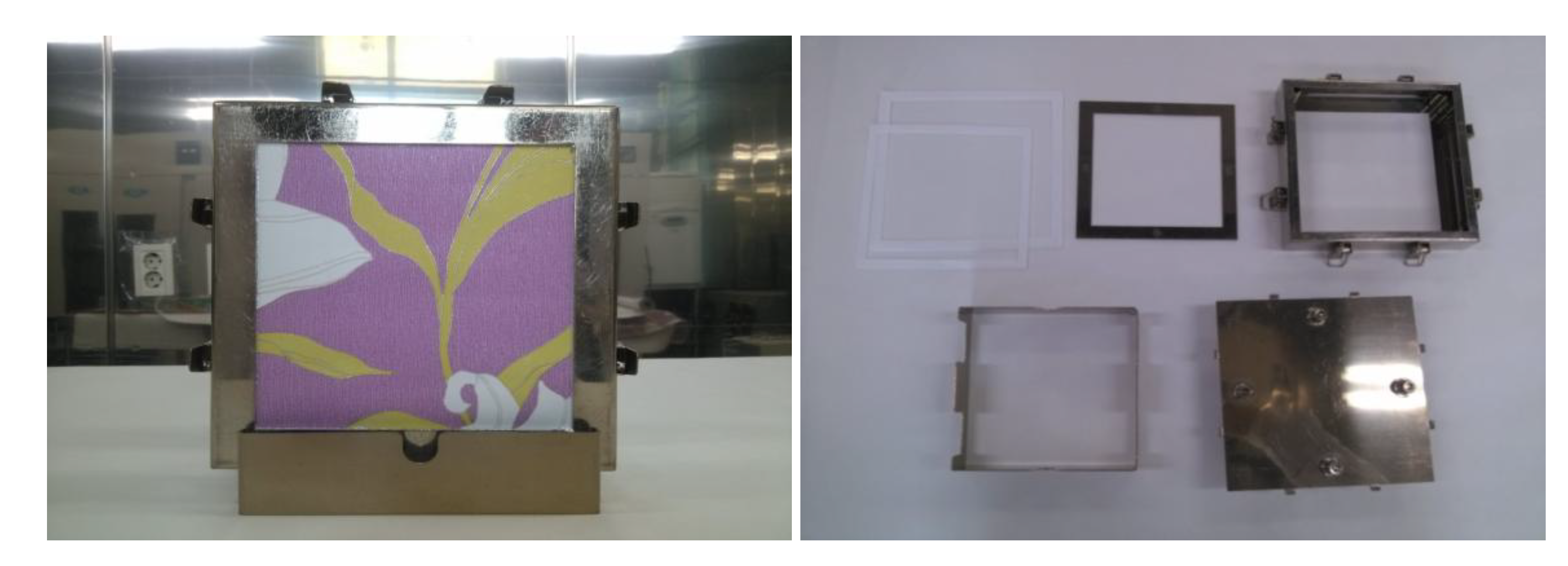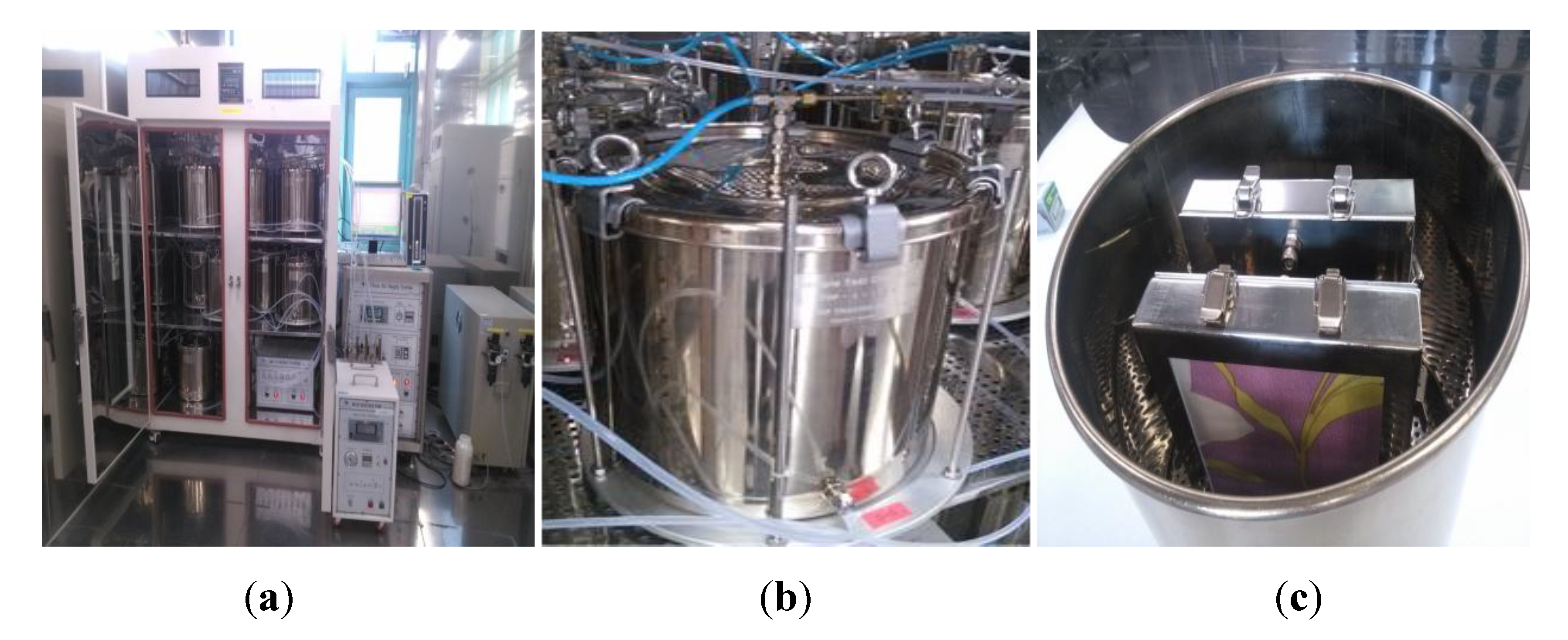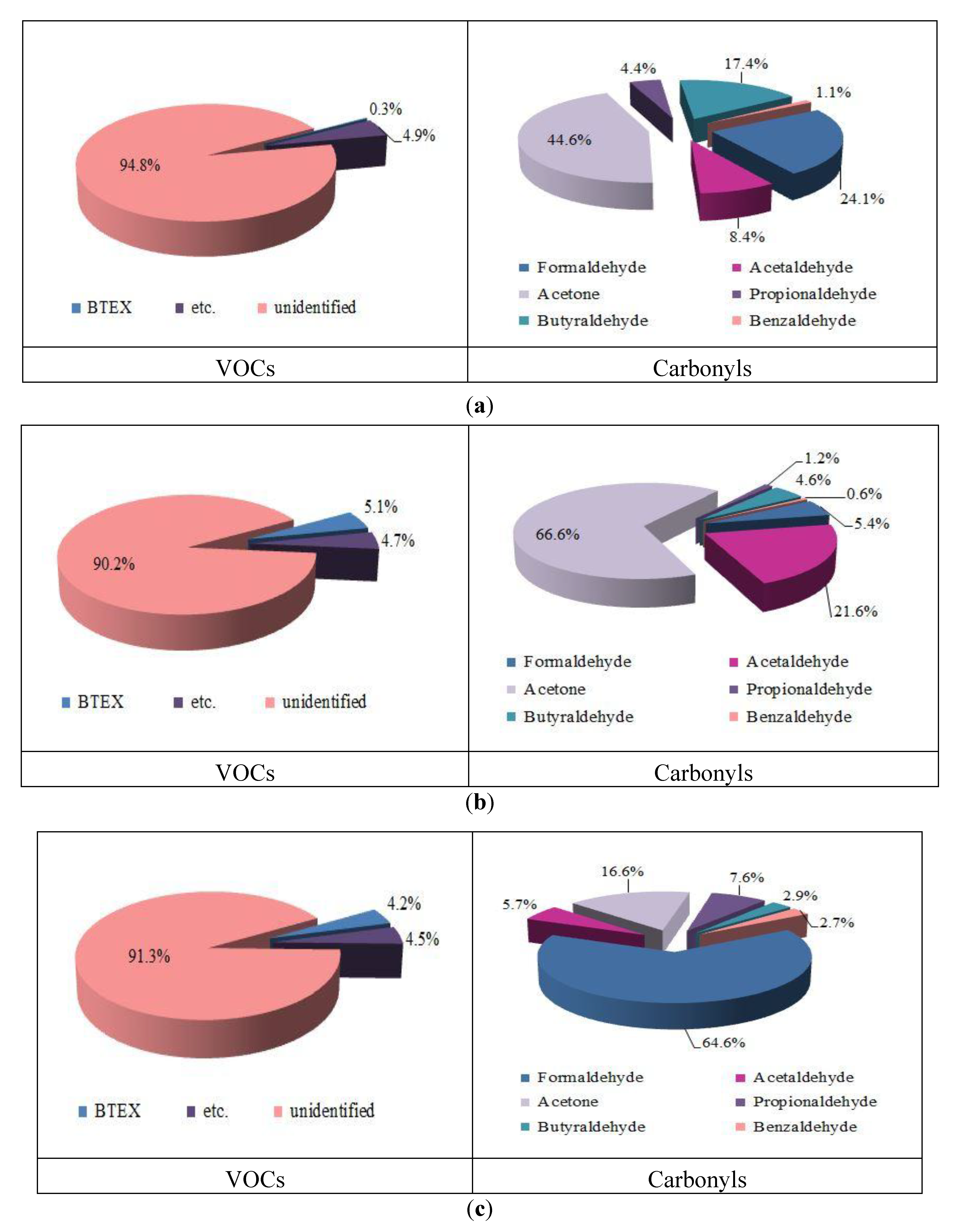Behavior of VOCs and Carbonyl Compounds Emission from Different Types of Wallpapers in Korea
Abstract
:1. Introduction
2. Experimental Section
2.1. Materials
| Product Class | Type of Products | Number of Products | Total |
|---|---|---|---|
| Wallpaper | PVC-coated | 179 | 332 |
| Paper-backed | 122 | ||
| Natural material-coated | 31 |
2.2. Sample Preparation

2.3. The 20 L Small Chamber System

2.4. Emission Test Conditions
| Parameter | Condition |
|---|---|
| Chamber volume | 20 L |
| Chamber material | Stainless-steel (E.P.) |
| Temperature & humidity | 25 ± 1 °C, 50 ± 5% |
| Specimen area | 432.2 cm2 |
| Loading factor | 2.0 ± 0.2 m2/m3 |
| Air exchange rate | 0.5 ± 0.05 h |
2.5. Sampling and Analysis
| Thermal Desorber | GC/MS | ||
|---|---|---|---|
| Parameter | Condition | Parameter | Condition |
| Instrument | STD 1000, DANI, Italy | Instrument | Shimadzu, GC-2010, Japan |
| Purge temp. and time | 40 °C, 1.0 min | GC column | VB-1 (0.25 mm, 60 m, 1.0 μm) |
| Desorption time and flow | 15 min, 100 mL/min | Split ratio | 10:1 |
| Desorption temp. | 300 °C | Initial temp. | 40 °C (6 min) |
| Cold trap holding time | 15 min | Oven ramp rate 1 | 4 °C/min (40–180 °C) |
| Cold trap high temp. | 320 °C | Oven ramp rate 2 | 20 °C/min(180–250 °C) |
| Cold trap low temp. | −10 °C | Final temp. | 250 °C (10 mi.) |
| Cold trap packing | Tenax-TA | Column flow | 1.5 mL/min |
| Split | No | MS source temp. | 200 °C |
| Valve temp. | 210 °C | Detector type | EI (Quadropole) |
| Transfer line temp. | 240 °C | Mass range | 35–350 amu |
| Electron energy | 70 eV | ||
| Parameter | Condition |
|---|---|
| Instrument | Waters alliance 2,695 separation module |
| Column | Waters sunfire C18 (150 mm × 4.6 mm × 3.5 μm) |
| Detector | Waters 2,487 dual absorbance detector |
| Mobile phase | Acetonitrile (A)/Water (B) |
| Gradient elution | 0–3 min: A/B = 60/40→60/40 3–8 min: A/B = 60/40→80/20 8–10 min: A/B = 80/20→100/0 10–20 min: A/B= 100/0→60/40 |
| Detection | Absorbance at 360 nm |
| Mobile phase flow rate | 1.0 mL/min |
| Injection volume | 10 μL |
2.6. Calculation of Emission Factor
3. Results and Discussion
3.1. Emission Factors of Major Pollutants
| Material | Pollutant | Emission Factor (mg/m2·h) | SD | ||
|---|---|---|---|---|---|
| Mean | Min | Max | |||
| PVC-coated (n = 179) | TVOC | 2.146 | 0.017 | 13.748 | 2.875 |
| Toluene | 0.003 | - | 0.066 | 0.006 | |
| Formaldehyde | 0.005 | - | 0.094 | 0.010 | |
| Paper-backed (n = 122) | TVOC | 0.304 | 0.001 | 6.896 | 0.852 |
| Toluene | 0.013 | - | 0.181 | 0.026 | |
| Formaldehyde | 0.002 | - | 0.024 | 0.004 | |
| Natural material-coated (n = 31) | TVOC | 0.137 | 0.002 | 0.822 | 0.176 |
| Toluene | 0.004 | - | 0.028 | 0.007 | |
| Formaldehyde | 0.008 | - | 0.040 | 0.012 | |

| Frequency of Occurrence | Emission Factor (mg/m2·h) | ||||||
|---|---|---|---|---|---|---|---|
| Rank | Chemical | No. of Products | % of Products | Chemical | Mean | Max | Min |
| 1 | Toluene | 274 | 82.5 | n-Tridecane | 0.0161 | 1.3362 | - |
| 2 | n-Undecane | 266 | 80.1 | n-Tetradecane | 0.0141 | 0.1853 | - |
| 3 | n-Tetradecane | 265 | 79.8 | Acetone | 0.0131 | 2.2741 | - |
| 4 | Formaldehyde | 264 | 79.5 | Decanal | 0.0082 | 0.2572 | - |
| 5 | o-Xylene | 263 | 79.2 | Toluene | 0.0081 | 0.2263 | - |
| 6 | 1,2,4-Trimethyl-benzene | 259 | 78.0 | n-Pentadecane | 0.0062 | 0.0625 | - |
| 7 | n-Dodecane | 257 | 77.4 | Formaldehyde | 0.0040 | 0.0944 | - |
| 8 | Ethylbenzene | 256 | 77.1 | n-Dodecane | 0.0039 | 0.0624 | - |
| 9 | m,p-Xylene | 255 | 76.8 | n-Undecane | 0.0037 | 0.0500 | - |
| 10 | n-Tridecane | 248 | 74.7 | Acetaldehyde | 0.0036 | 0.5799 | - |
3.2. Frequencies of Occurrence and Concentrations of Chemicals
3.3. Composition Ratios for VOCs and Carbonyls

4. Conclusions
Acknowledgments
Author Contributions
Conflicts of Interest
References
- International Agency for Research on Cancer (IARC). In IARC Monographs on the Evaluation of Carcinogenic Risks to Humans; WHO/IARC: Lyon, France, 2006; p. 88.
- Katsoyiannis, A.; Leva, P.; Barrero-Moreno, J.; Kotzias, D. Building materials, VOC emissions, diffusion behavior and implications from their use. Environ. Pollut. 2012, 169, 230–234. [Google Scholar] [CrossRef]
- Que, Z.L.; Wang, F.B.; Li, J.Z.; Furuno, T. Assessment on emission of volatile organic compounds and formaldehyde from building materials. Compos. Part B-Eng. 2013, 49, 36–42. [Google Scholar] [CrossRef]
- Wolkoff, P. How to measure and evaluate volatile organic compound emission from building products: A perspective. Sci. Total Environ. 1999, 227, 197–213. [Google Scholar] [CrossRef]
- Yu, C.; Crump, D. A review of the emission of VOCs from polymeric materials used in buildings. Bldg. Environ. 1998, 33, 357–374. [Google Scholar] [CrossRef]
- Liu, Z.; Ye, W.; Little, J.C. Predicting emissions of volatile and semivolatile organic compounds from building materials: A review. Bldg. Environ. 2013, 64, 7–25. [Google Scholar] [CrossRef]
- Kim, S. Control of formaldehyde and TVOC emission from wood-based flooring composites at various manufacturing processes by surface finishing. J. Hazard. Mater. 2010, 176, 14–19. [Google Scholar] [CrossRef]
- Salem, M.Z.M.; BÖhm, M.; Srba, J.; Beránkova, J. Evaluation of formaldehyde emission from different types of wood-based panels and flooring materials using different standard test methods. Bldg. Environ. 2012, 49, 86–96. [Google Scholar] [CrossRef]
- Bohm, M.; Salem, M.Z.M.; Srba, J. Formaldehyde emission monitoring from a variety of solid wood, plywood, blockboard and flooring products manufactured for building and furnishing materials. J. Hazard. Mater. 2012, 221, 68–79. [Google Scholar] [CrossRef]
- Kim, S.; Kim, J.A.; Kim, H.J.; Kim, S.D. Determination of formaldehyde and TVOC emission factor from wood-base composites by small chamber method. Polym. Test. 2006, 25, 605–614. [Google Scholar] [CrossRef]
- He, Z.; Zhang, Y.; Wei, W. Formaldehyde and VOC emissions at different manufacturing stages of wood-based panels. Bldg. Environ. 2012, 47, 197–204. [Google Scholar] [CrossRef]
- Yrieix, C.; Dulaurent, A.; Laffargue, C.; Maupetit, F.; Pacary, T.; Uhde, E. Characterization of VOC and formaldehyde emission from a wood based panel: Results from an inter-laboratory comparison. Chemosphere 2010, 79, 414–419. [Google Scholar] [CrossRef]
- Zuraimi, M.S.; Roulet, C.A.; Tham, K.W.; Sekhar, S.C.; Cheong, K.W.D.; Wong, N.H.; Lee, K.H. A comparative study of VOCs in Singapore and European office buildings. Bldg. Environ. 2006, 41, 316–329. [Google Scholar] [CrossRef]
- Katsoyiannis, A.; Leva, P.; Kotzias, D. VOC and carbonyl emissions from carpets:A comparative study using of environmental chambers. J. Hazard. Mater. 2008, 152, 669–676. [Google Scholar] [CrossRef]
- Kim, K.W.; Kim, S.; Kim, H.J.; Park, J.C. Formaldehyde and TVOC emission behaviors according to finishing treatment with surface materials using 20 L chamber and FLEC. J. Hazard. Mater. 2010, 177, 90–94. [Google Scholar] [CrossRef]
- Wilke, O.; Jann, O.; Brödner, D. VOC and SVOC emissions from adhesives, floor coverings and complete floor structures. Indoor Air 2004, 14, 98–107. [Google Scholar] [CrossRef]
- An, J.Y.; Kim, S.; Kim, H.J. Formaldehyde and TVOC emission behavior of laminate flooring by structure of laminate flooring and heating condition. J. Hazard. Mater. 2011, 187, 44–51. [Google Scholar] [CrossRef]
- An, J.Y.; Kim, S.; Kim, H.J.; Seo, J. Emission behavior of formaldehyde and TVOC from engineered flooring in under heating and air circulation systems. Bldg. Environ. 2010, 45, 1826–1833. [Google Scholar] [CrossRef]
- Wiglusz, R.; Sitko, E.; Nikel, G.; Jarnuszkiewicz, E.; Igielska, B. The effect of temperature on the emission of formaldehyde and volatile organic compounds (VOCs) from laminate flooring-case study. Bldg. Environ. 2002, 37, 41–44. [Google Scholar] [CrossRef]
- Kim, J.A.; Kim, S.; Kim, H.; Kim, Y. Evaluation of formaldehyde and VOCs emission factors from paints in a small chamber: The effects of preconditioning time and coating weight. J. Hazard. Mater. 2011, 187, 52–57. [Google Scholar] [CrossRef]
- Järnström, H.; Saarela, K.; Kalliokoski, P.; Pasanen, A.L. Comparison of VOC and ammonia emissions from individual PVC materials, adhesives and from complete structures. Envrion. Int. 2008, 34, 420–427. [Google Scholar] [CrossRef]
- Nicolle, J.; Desauziers, V.; Mocho, P.; Ramalho, O. Optimization of FLEC-SPME for field passive sampling of VOCs emitted from solid building materials. Talanta 2009, 80, 730–737. [Google Scholar] [CrossRef]
- Kim, S. The reduction of formaldehyde and VOCs emission from wood-based flooring by green adhesive using cashew nut shell liquid (CNSL). J. Hazard. Mater. 2010, 182, 919–922. [Google Scholar] [CrossRef]
- Myoung, S.W.; Jung, S.I.; Kim, E.H.; Jung, Y.G.; Nam, Y.S.; Kyoung, W.S. Fabrication and characterization of eco-friendly functional wallpaper using nonmetallic minerals. Prog. Org. Coating. 2009, 64, 311–316. [Google Scholar] [CrossRef]
- ISO 16000–9:2006 Indoor Air—Part 9: Determination of the Emission of Volatile Organic Compounds from Building Products and Furnishing—Emission test chamber method. Available online: http://www.iso.org/iso/home/store/catalogue_tc/catalogue_detail.htm?csnumber =38203 (accessed on 14 April 2014).
- ISO 16000–11:2006 Indoor air—Part 11: Determination of the Emission of Volatile Organic Compounds from Building Products and Furnishing—Sampling, Storage of Samples and Preparation of Test Specimens. Available online: http://www.iso.org/iso/home/store/catalogue_tc/ catalogue_detail.htm?csnumber=38205 (accessed on 14 April 2014).
- Sarigiannis, D.A.; Karakitsios, S.P.; Gotti, A.; Liakos, I.L.; Katsoyiannis, A. Exposure to major volatile compounds and carbonyls in European indoor environments and associated health risk. Environ. Int. 2011, 37, 743–765. [Google Scholar]
© 2014 by the authors; licensee MDPI, Basel, Switzerland. This article is an open access article distributed under the terms and conditions of the Creative Commons Attribution license (http://creativecommons.org/licenses/by/3.0/).
Share and Cite
Lim, J.; Kim, S.; Kim, A.; Lee, W.; Han, J.; Cha, J.-S. Behavior of VOCs and Carbonyl Compounds Emission from Different Types of Wallpapers in Korea. Int. J. Environ. Res. Public Health 2014, 11, 4326-4339. https://doi.org/10.3390/ijerph110404326
Lim J, Kim S, Kim A, Lee W, Han J, Cha J-S. Behavior of VOCs and Carbonyl Compounds Emission from Different Types of Wallpapers in Korea. International Journal of Environmental Research and Public Health. 2014; 11(4):4326-4339. https://doi.org/10.3390/ijerph110404326
Chicago/Turabian StyleLim, Jungyun, Suejin Kim, ARong Kim, Wooseok Lee, Jinseok Han, and Jun-Seok Cha. 2014. "Behavior of VOCs and Carbonyl Compounds Emission from Different Types of Wallpapers in Korea" International Journal of Environmental Research and Public Health 11, no. 4: 4326-4339. https://doi.org/10.3390/ijerph110404326




